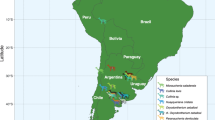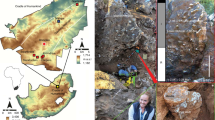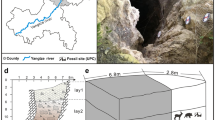Abstract
Jouffroy (Bulletin du Muséum National d'Histoire Naturelle. Série 2 31:209–216, 1959) described Macaca speciosa subfossilis on the basis of her study of the external anatomy of a nearly complete cranium (PV F1; Muséum national d’Histoire naturelle, Paris) found in the Late Pleistocene cave deposits, Thung-Lang, northern Vietnam. Whereas Jouffroy (Bulletin du Muséum National d'Histoire Naturelle. Série 2 31:209–216, 1959) considered it to belong to an ancestor of Macaca arctoides or M. thibetana, Fooden (Journal of Human Evolution 19:607–686, 1990) reexamined the facial anatomy and assigned it to the extant species M. arctoides. We used computed tomography images to reevaluate the phylogenetic position of Macaca speciosa subfossilis by comparing the external and internal features of PV F1 with those of the crania of the extant macaque species. PV F1 shows a lower degree of preorbital concavity than Macaca arctoides, M. assamensis, and M. thibetana, but shares an anteriorly directed malar as seen in the crania of the two former species. The size of the molars of PV F1 falls within a range such that the cranium may be assigned to any of the five species of Macaca arctoides, M. assamensis, M. thibetana, M. mulatta, and M. nemestrina. An analysis of the internal structure of the cranium reveals that only PV F1 and the cranium of Macaca arctoides have a pear-shaped nasal cavity expanding laterally at both the anterior and posterior regions. Such a feature is probably a derived condition in the macaque lineage, suggesting a close relationship between Macaca speciosa subfossilis and M. arctoides. This finding supports the paleobiological scenario that the members of the lineage of Macaca arctoides diverged from the other members of Asian macaques and became distributed in northern Vietnam as early as the Late Pleistocene.








Similar content being viewed by others
References
Cronin, J. E., Cann, R., & Sarich, V. M. (1980). Molecular evolution and systematics of the genus Macaca. In D. G. Lindburg (Ed.), The macaques: Studies in ecology, behavior and evolution (pp. 31–51). New York: Van Nostrand Reinhol.
Deinard, A., & Smith, D. G. (2001). Phylogenetic relationships among the macaques: evidence from the nuclear locus NRAMP1. Journal of Human Evolution, 41, 45–59.
Delson, E. (1980). Fossil Macaques, phyletic relationships and a scenario of deployment. In D. G. Lindburg (Ed.), The macaques: Studies in ecology, behavior and evolution (pp. 10–30). New York: Van Nostrand Reinhol.
Farris, J. S. (1989). The retention index and the rescaled consistency index. Cladistics, 5, 417–419.
Fooden, J. (1980). Classification and distribution of living macaques (Macaca Lacépède, 1799). In D. G. Lindburg (Ed.), The macaques: Studies in ecology, behavior and evolution (pp. 1–9). New York: Van Nostrand Reinhol.
Fooden, J. (1988). Taxonomy and evolution of the sinica group of macaques: 6. Interspecific comparisons and synthesis. Fieldiana Zool, 45, 1–44.
Fooden, J. (1990). The bear macaques, Macaca arctoides: a systematic review. Journal of Human Evolution, 19, 607–686.
Fooden, J., & Lanyon, S. M. (1989). Blood-protein allele frequencies and phylogenetic relationships in macaca: a review. American Journal of Primatology, 17, 209–241.
Jablonski, N. G. (2002). Fossil old world monkeys: The late Neogene radiation. In W. C. Hartwig (Ed.), The primate fossil record (pp. 255–299). New York: Cambridge University Press.
Jouffroy, F. K. (1959). Un crane subfossile de macaque du Pléistocène du Viet Nam. Bulletin du Muséum National d’Histoire Naturelle. Série 2, 31, 209–216.
Koppe, T., & Nagai, T. (1999). Quantitative analysis of the maxillary sinus in Catarrhine Primates. In T. Koppe, H. Nagai & K. W. Alt (Eds.), The paranasal sinuses of highter primates: development, function, and evolution (p. 121). Berlin: Quintessence.
Koppe, T., & Ohkawa, Y. (1999). Pneumatization of the facial skelton in Catarrhine Primates. In T. Koppe, H. Nagai & K. W. Alt (Eds.), The paranasal sinuses of highter primates: development, function, and evolution (pp. 77–119). Berlin: Quintessence.
Koppe, T., & Rae, T. C. (2001). Factors influencing the pneumatization of the alveolar process in Macaques. In A. Brook (Ed.) 12th International symposium on dental morphology (pp. 267–276). Sheffield: Sheffield Academic Press Ltd.
Koppe, T., Rae, T. C., & Swindler, D. R. (1999). Influence of craniofacial morphology on primate paranasal pneumatization. Annals of Anatomy, 181, 77–80.
Li, Q. Q., & Zhang, Y. P. (2005). Phylogenetic relationships of the macaques (Cercopithecidae: Macaca), inferred from mitochondrial DNA sequences. Biochemical Genetics, 43, 375–386.
Liu, D., & Ding, M. (1984). The characteristics and evolution of the palaeoenvironment of China since the Late Tertiary. In R. O. Whyte (Ed.) The Evolution of the East Asian environment (pp. 11-40) Hong Kong: Center of Asian studies, University of Hong Kong.
Maddison, D. R., & Maddison, W. P. (2000). MacClade 4: Analysis of phylogeny and character evolution. Version 4.0. Sunderland: Sinauer Associates.
Morales, J. C., & Melnick, D. J. (1998). Phylogenetic relationships of the macaques (Cercopithecidae: Macaca), as revealed by high resolution restriction site mapping of mitochondrial ribosomal genes. Journal of Human Evolution, 34, 1–23.
Nishimura, T. D., Takai, M., & Maschenko, E. N. (2007). The maxillary sinus of Paradolichopithecus sushkini (late Pliocene, southern Tajikistan) and its phyletic implications. Journal of Human Evolution, 52, 637–646.
Pan, R., Jablonski, N. G., Oxnard, C., & Freedman, L. (1998). Morphometric analysis of Macaca arctoides and M. thibetana in relation to other macaque species. Primates, 39, 519–537.
Rae, T. C. (2008). Paranasal pneumatization in extant and fossil Cercopithecoidea. Journal of Human Evolution, 54, 279–286.
Rae, T. C., Hill, R. A., Hamada, Y., & Koppe, T. (2003). Clinical variation of sinus volume in Japanese Macaques (Macaca fuscata). American Journal of Primatology, 59, 153–158.
Rae, T. C., Röhrer–Ertl, O., Wallner, C–. P., & Koppe, T. (2007). Paranasal pneumatization of two late Miocene colobines: Mesopithecus and Libypithecus (Cercopithecidae: Primates). Journal of Vertebrate Paleontology, 27, 768–771.
Rossie, J. B. (2005). Anatomy of the nasal cavity and paranasal sinuses in Aegyptopithecus and early Miocene African Catarrhines. American Journal of Anthropology, 126, 250–267.
Rossie, J. B., Simons, E. L., Gauld, S. C., & Rasmussen, D. T. (2002). Paranasal sinus anatomy of Aegyptopithecus: implications for hominoid origins. Proceedings of the National Academy of Sciences, 99, 8454–8456.
Schlosser, M. (1924). Fossil Primates from China. Palaeontologia Sinica. Series C, 1, 1–16.
Singleton, M. (2002). Patterns of cranial shape variation in the Papionini (Primates; Cercopithecinae). Journal of Human Evolution, 42, 547–578.
Smith, T. D., Rossie, J. B., & Bhatnagar, K. P. (2007). Evolution of the nose and nasal skeleton in Primates. Evolutionary Anthropology, 16, 132–146.
Stierna, P. L. E. (2001). Physiology, mucociliary clearance, and neural control. In D. Kennedy, W. Bolger & S. Zinnreich (Eds.), Diseases of the sinuses: Diagnosis and management (pp. 35–45). Hamilton: B.C. Decker.
Szalay, F. S., & Delson, E. (1979). Evolutionary history of the primates. New York: Academic.
Thierry, B., Iwaniuk, A. N., & Pellis, S. M. (2000). The influence of phylogeny on the social behavior of macaques (Primates: Cercopithecidae, genus Macaca). Ethology, 106, 713–728.
Tosi, A. J., Morales, J. C., & Melnick, D. J. (2000). Comparison of Y chromosome and mtDNA phylogenies leads to unique inferences of macaque evolutionary history. Molecular Phylogenetics and Evolution, 17, 133–144.
Tosi, A. J., Morales, J. C., & Melnick, D. J. (2003). Paternal, maternal, and biparental molecular markers provide unique windows onto the evolutionary history of macaque monkeys. Evolution, 57, 1419–1435.
Young, C. C. (1934). On the Insectivora, Chiroptera, Rodentia and Primates other than Sinanthropus from locality 1 of Choukoutien. Palaeontologia Sinica. Series C, 8, 122–128.
Acknowledgments
We thank the Muséum national d’Histoire naturelle (Paris), the Japan Monkey Centre (JMC), Okayama University Hospital, and Laboratory of Physical Anthropology (KAS) and the Primate Research Institute (PRI) of the Kyoto University for offering us the opportunities to scan the specimens. We thank Todd C. Rae of the University of Roehampton; Daisuke Shimizu of JMC; José Braga in the Université Paul Sabatier; Arnaud Beck in the Institut de Médecine et de Physiologie Spatiales; Sylvie Charreau and Albeal Mvoto of the Clinique Pasteur, Toulouse; Masato Nakatsukasa, Naomichi Ogihara, and Wataru Yano of KAS; Zin Maung Maung Thein of PRI; and Taung Htike of Shwebo Degree College for their help for CT scanning. We thank Naoko Egi of PRI for her supportive advice on phyletic analysis, and Elizabeth Nakajima for checking the English text. We also greatly appreciate Joanna Setchell and 2 anonymous reviewers for improving the quality of this paper. This research was financially supported in part by a Grant-in-Aid for Scientific Research from the Japan Society for the Promotion of Science Grant 21770263 to T. D. Nishimura; Grant 20405015 to M. Takai), by the Ito Foundation, Tokyo (to T. D. Nishimura), by GDRI CNRS, France (to B. Senut), and by the Global Center of Excellence Program Formation of a Strategic Base for Biodiversity and Evolutionary Research: from Genome to Ecosystem of the Ministry of Education, Culture, Sports, Science and Technology, Japan (Grant A06 to Kyoto University).
Author information
Authors and Affiliations
Corresponding author
Rights and permissions
About this article
Cite this article
Ito, T., Nishimura, T.D., Senut, B. et al. Reappraisal of Macaca speciosa subfossilis from the Late Pleistocene of Northern Vietnam Based on the Analysis of Cranial Anatomy. Int J Primatol 30, 643–662 (2009). https://doi.org/10.1007/s10764-009-9365-y
Received:
Accepted:
Published:
Issue Date:
DOI: https://doi.org/10.1007/s10764-009-9365-y




